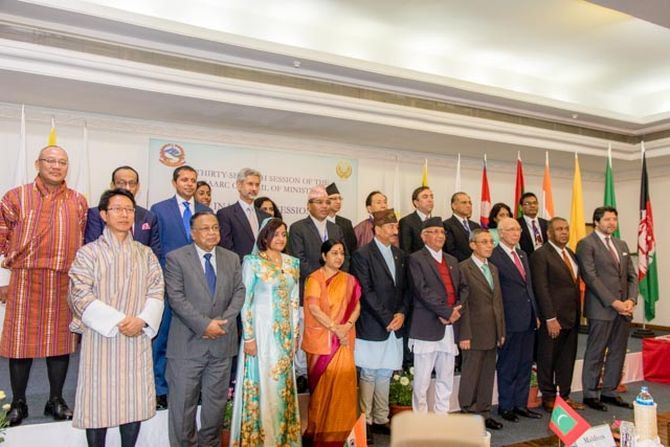Connectivity is what SAARC needs most, but Pakistan remains a stumbling block, says Rajeev Sharma.

When External Affairs Minister Sushma Swaraj pitched for two C's -- Connectivity and Collective Strength -- at the 37th South Asian Association for Regional Cooperation Council of Ministers meeting in Pokhara, Nepal on March 17, her speech was meant for only one member of the eight-nation grouping: Pakistan.
This is not the first time, nor will it be the last time, when India put a laser beam focus on connectivity to propel growth, peace and prosperity among the SAARC countries of Afghanistan, Bangladesh, Bhutan, India, Maldives, Nepal, Pakistan and Sri Lanka.
But Pakistan has consistently blocked India's initiatives in this regard. Just before the last summit, the 17th in Kathmandu in November 2014, Pakistan had blocked three key connectivity agreements, including the SAARC motor vehicle pact, saying it was yet to conclude its 'internal process.'
Now Pakistan is scheduled to host the 18th SAARC summit later this year and indications emanating from Islamabad are that the Pakistani attitude remains the same.
Without forging connectivity, SAARC will continue to be an ineffective regional grouping and a mere talk shop that it has been since 30 years of its existence.
This formed the core and kernel of Sushma Swaraj's speech at the Pokhara meeting on Thursday, March 17.
Sample her relevant quote in this context: 'Connectivity is central to our development and will determine how we meet our goals of growth, employment, and prosperity.'
'As we seek to overcome basic problems of physical connectivity, it is important for us to move forward quickly on pending agreements on rail and motor vehicles. Economic activities, cultural connections and people to people contacts will flow naturally from such connectivity.'
2010-2020 is the designated SAARC decade of intra-regional connectivity. This is the most important thrust area for an organisation like SAARC which is now full grown adult in terms of age.
However, in terms of its concrete deliverables SAARC remains a toddler; a dream that has been high on dreaming part, but low on the realisation part. Connectivity still remains a major to-do task.
And yet this three-decade-old dream remains eminently fully achievable and capable of being translated into reality. The Association of Southeast Asian Nations is a role model while the European Union is the gold standard in terms of regional cooperation groupings.
SAARC, now at 30, is well placed to emulate both.
In fact there are four C's that are important drivers in the SAARC narrative: Connectivity, Commerce, Cooperation and Culture. But the first 'C' subsumes all other C's. If connectivity is achieved, the three other C's would automatically be achieved.
In this age of social media where boundaries mean little, connectivity is of utmost importance. We are talking of connectivity of all kinds -- infrastructural, cultural, trade and people-to-people.
Prime Minister Narendra Modi laid ample focus on all four C's in his speech at the November 2014 SAARC summit in Kathmandu and remarked thus: 'There is a new awakening in South Asia; a new recognition of inter-linked destinies; and, a new belief in shared opportunities. The bonds will flow. Through SAARC or outside it. Among us all or some of us.'
This remark not only displayed India's frustration in persuading nay-sayers (read Pakistan) to come around and use the collective strength of the regional; grouping to the hilt but also concealed a warning to the nay-sayers.
What Modi meant was that the juggernaut of connectivity was now unstoppable and if Pakistan continued to block such moves, India will tap other routes.
One such sub-regional route within the SAARC framework is BBIN (Bangladesh, Bhutan, India and Nepal). Incidentally, BBIN has already implemented the motor vehicle pact. This happened close on the heels of the Kathmandu summit when the BBIN sub-grouping signed on June 16, 2015 a Motor Vehicles Agreement to ensure free and unfettered movement of passenger, personal and cargo vehicles.
This historic step will break the barriers between these four nations in the SAARC grouping and bring them closer. The agreement will facilitate the transit of all types of vehicles as is prevalent in other regions like the European Union.
SAARC's loss has been BBIN's gain.
Pakistan can still make amends later this year when it hosts the SAARC summit. SAARC today stands at the cusp of an important point of its 30-year-old history as most member States have stable and strong governments and that should infuse a new vitality into the regional cooperation grouping.
But will Pakistan change its tactics? Well, it looks highly unlikely.
Rajeev Sharma is an independent journalist and strategic analyst who tweets @Kishkindha










